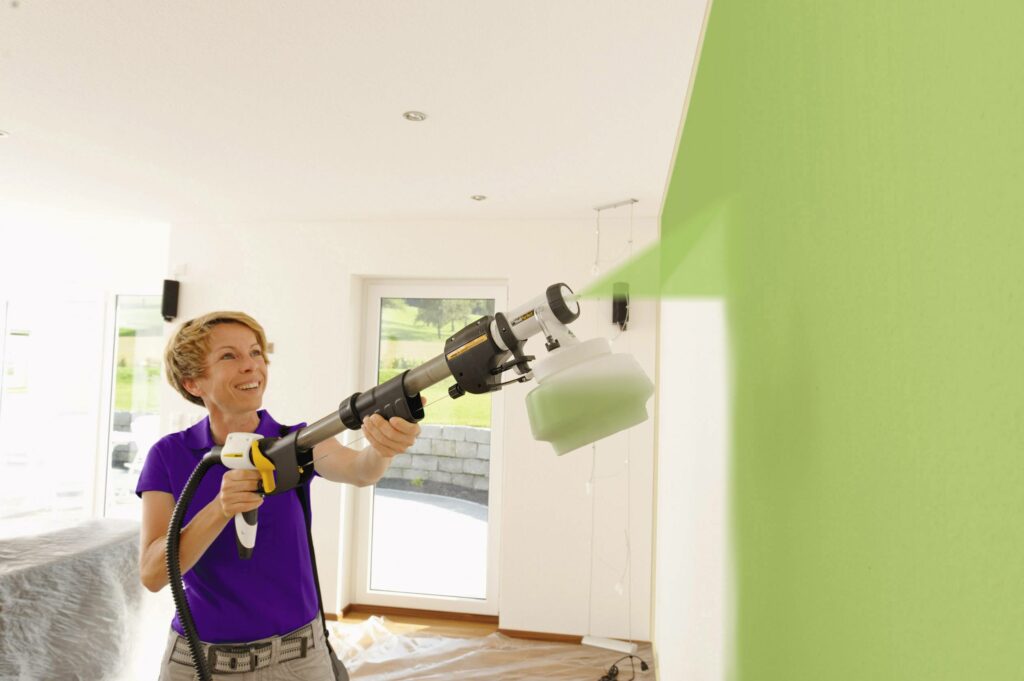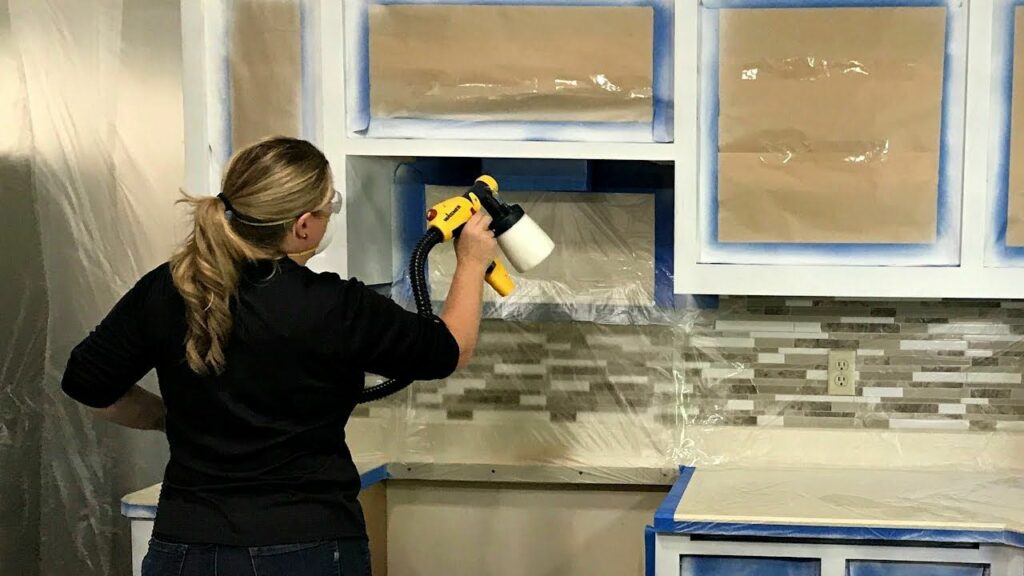Kitchen spray paint Transforming your kitchen can be a daunting task, especially when considering a full renovation. However, there’s a cost-effective and efficient way to give your kitchen a fresh, modern look: kitchen spray paint. This versatile solution can revitalize your cabinets, drawers, and even appliances, making them look brand new. In this comprehensive guide, we’ll explore everything you need to know about kitchen spray paint, from its benefits to the step-by-step application process Kitchen spray paint.

What is Kitchen Spray Paint?
Kitchen spray paint is a type of paint specifically formulated for use in kitchen environments. It’s designed to adhere to various surfaces such as wood, metal, and plastic, providing a durable and smooth finish. Unlike traditional brush-on paints, kitchen spray paint offers a more even coat with fewer brush marks, making it ideal for achieving a professional look.
Benefits of Kitchen Spray Paint
Using kitchen spray paint has several advantages:
Cost-Effective
Renovating a kitchen can be expensive. Kitchen spray paint allows you to update the look of your kitchen without the high costs associated with replacing cabinets and appliances.
Timesaving
Spray painting is generally faster than brush painting. It covers large areas quickly and evenly, reducing the time spent on the project.
Versatility
Kitchen spray paint can be used on various surfaces, including wood, metal, and plastic, making it suitable for cabinets, drawers, and appliances.
Professional Finish
The spray application provides a smooth and even coat, eliminating brush marks and achieving a professional-grade finish.
Wide Range of Colors
Kitchen spray paint is available in numerous colours, allowing you to choose the perfect shade to match your kitchen’s décor.
Preparing Your Kitchen for Spray Painting
Preparation is key to achieving the best results with kitchen spray paint. Here’s how to prepare your kitchen:
Clear the Area
Remove all items from your cabinets, drawers, and countertops. Cover appliances and surfaces that won’t be painted with plastic sheets or drop cloths.
Clean Surfaces
Thoroughly clean all surfaces to be painted with a degreaser to remove grease and grime. This ensures better paint adhesion.
Remove Hardware
Take off handles, knobs, and hinges from cabinets and drawers. This allows for a more even application of the paint.
Sand Surfaces
Lightly sand the surfaces to be painted to create a rough texture for better paint adhesion. Remove any dust using a slightly damp cloth.
Apply Primer
Apply a suitable primer for the material you’re painting. This enhances the adhesion of the kitchen spray paint and improves durability.
Choosing the Right Kitchen Spray Paint
Selecting the right kitchen spray paint is crucial for achieving a long-lasting and beautiful finish. Consider the following factors:
Surface Compatibility
Ensure the paint is suitable for the surfaces you’ll be painting, such as wood, metal, or plastic.
Finish
Choose between different finishes like matte, satin, gloss, or semi-gloss. The finish will affect the look and feel of your kitchen.
Colour
Pick a colour that complements your kitchen’s décor. Kitchen spray paint comes in a wide range of colours, from classic neutrals to bold hues.
Durability
Opt for high-quality, durable paint that can withstand the kitchen environment, including moisture and heat.
Step-by-Step Guide to Applying Kitchen Spray Paint
Follow these steps for a successful kitchen spray paint application:
Ventilate the Area
Ensure proper ventilation in your kitchen by opening windows and using fans. This helps to dissipate fumes and speed up drying time.
Shake the Can
Shake the spray paint vigorously for at least one minute to mix the paint thoroughly.
Test Spray
Test the spray paint on a piece of cardboard or scrap material to ensure the nozzle is working correctly and to practise your spraying technique.
Apply Light Coats
Hold the can about 12 inches from the surface and apply light, even coats. Start with a thin coat to avoid drips and runsAllow each coat to dry completely before applying the next.
Multiple Coats
Apply several light coats until you achieve the desired coverage and colour intensity. This typically requires two to three coats.
Drying Time
Ensure the paint dries thoroughly between each coat and after the final coat.. Refer to the manufacturer’s instructions for drying times.
Reassemble Hardware
Once the paint is fully dry, reattach handles, knobs, and hinges to your cabinets and drawers.
Maintenance Tips for Kitchen Spray Painted Surfaces
To keep your kitchen spray painted surfaces looking their best, follow these maintenance tips:
Regular Cleaning
Wipe down surfaces regularly with a damp cloth to remove dust and spills.Refrain from using abrasive cleaners, as they can harm the paint.
Avoid Excessive Moisture
Keep painted surfaces dry to prevent water damage. Wipe up spills promptly and use coasters and mats to protect surfaces.
Touch-Ups
Keep a small amount of kitchen spray paint for touch-ups. If you notice chips or scratches, lightly sand the area and apply a small amount of paint to blend it in.
Frequently Asked Questions (FAQs)
Q: Can I use kitchen spray paint on all types of cabinets?
A: Kitchen spray paint is suitable for most types of cabinets, including wood, laminate, and metal. Ensure you choose a paint that is compatible with the material of your cabinets.
Q: How long does kitchen spray paint take to dry?
A: The drying times depend on the type of paint used and the environmental conditions. Typically, kitchen spray paint dries to the touch within 1-2 hours and fully cures within 24-48 hours.
Q: Is it necessary to use a primer before applying kitchen spray paint?
A: Using a primer is recommended as it enhances paint adhesion and improves the durability of the finish. It also helps to cover any existing stains or colours.
Q: Can I spray paint my kitchen appliances?
A: Yes, you can use kitchen spray paint on appliances. Ensure you use paint specifically designed for appliances and follow the manufacturer’s instructions for the best results.
Q: How do I prevent drips and runs when using kitchen spray paint?
A: To avoid drips and runs, apply several light coats instead of one heavy coat. Hold the spray can at a consistent distance from the surface and move it in smooth, even strokes.
Q: What is the best finish for kitchen spray paint?
A6: The best finish depends on your preference and kitchen style. Gloss and semi-gloss finishes are popular for their durability and easy cleaning, while matte and satin finishes offer a more subdued look.
Q: Can I change the colour of my cabinets with kitchen spray paint?
A: Yes, kitchen spray paint is an excellent way to change the colour of your cabinets. It offers a wide range of colour options to suit your design preferences.
Q: How do I clean spray paint nozzles after use? A8: After use, turn the can upside down and spray until no paint comes out. This clears the nozzle and prevents clogging.
Q: Is kitchen spray paint safe to use indoors?
A: Yes, kitchen spray paint is safe to use indoors. Ensure proper ventilation during application and follow the safety instructions on the paint can.
Q: Can I achieve a professional finish with kitchen spray paint?
A: Yes, with proper preparation and application, you can achieve a professional-quality finish with kitchen spray paint.

Conclusion
Transforming your kitchen with kitchen spray paint is a cost-effective and efficient way to achieve a stunning makeover. By following the steps outlined in this guide, you can refresh your cabinets, drawers, and appliances, giving your kitchen a new lease on life. With the right preparation, application, and maintenance, your kitchen spray painted surfaces will look beautiful and last for years to come. So, grab your kitchen spray paint, and start your journey to a revitalized culinary space today!

